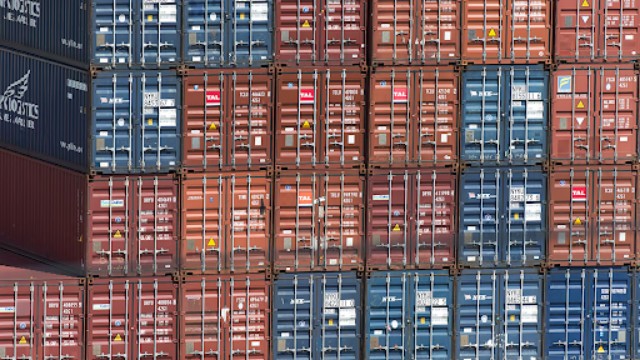
Shipping containers sit stacked at a terminal in Halifax on August 25, 2017. (Photo: Andrew Vaughan / The Canadian Press)
Ottawa — Canada is beginning to shift its trade focus away from the United States, turning instead to other international markets. In March, trade between Canada and the U.S. dropped sharply, largely due to new tariffs introduced by both countries. But Canadian exporters didn’t sit idle. They found new customers abroad, easing the downturn's impact with a sharp rise in overseas shipments.
According to Statistics Canada, exports to the United States dropped by 6.6% during the month. But this shortfall was nearly wiped out by a remarkable 24.8% increase in exports to other countries. The surge in international trade helped Canada achieve one of its largest monthly export growth rates on record.
This dramatic shift in trade patterns follows a heated exchange of tariffs between Canada and the United States. In early March, Washington imposed broad duties on Canadian imports, prompting Ottawa to retaliate with its own set of trade restrictions.
At the same time, Canada’s imports from the U.S. fell by 2.9%, reflecting both public frustration and declining business confidence in its closest trading partner. The changing mood came as Prime Minister Mark Carney prepared to meet U.S. President Donald Trump in Washington to discuss the tense trade relationship and broader security concerns.
Carney, who recently won reelection promising to take a tougher stance on U.S. trade policy, made it clear last week that the days of close-knit economic cooperation with the U.S. are behind them. “Our old relationship based on steadily increasing integration is over,” he said, pledging to expand Canada's trade partnerships elsewhere.
In terms of overall trade, total exports dipped slightly by 0.2%, mainly due to lower prices. Total imports fell by 1.5%. As a result, Canada’s trade deficit shrank significantly, dropping from CAN$1.4 billion in February to just CAN$506 million in March.
However, Canada's trade surplus with the U.S. also took a hit, decreasing to CAN$8.4 billion. Despite the drop, Canada found strength in other markets. There was a notable increase in gold exports to the United Kingdom, crude oil shipments to the Netherlands, and various products sent to Germany. Exports of motor vehicles and auto parts also jumped ahead of April's expected U.S. tariffs on that sector.
Not all sectors fared well, though. Pharmaceutical and uranium exports to the U.S. fell, as did pork exports to Asia. Natural gas shipments also declined.
The impact of steel and aluminum tariffs remained mixed. Steel exports dropped, while aluminum exports rose for the fourth straight month. Imports of steel declined, whereas aluminum imports climbed.
Analysts believe the worst may still lie ahead. “Canada should brace for increasing headwinds to trade,” warned TD Economics analyst Marc Ercolao. He predicted that the deeper effects of the ongoing trade conflict will become clearer in the coming months.















